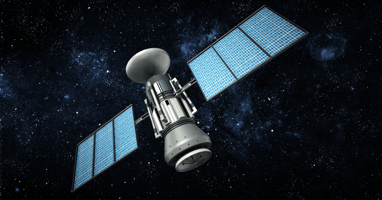Portuguese Air Force relies on Neuraspace to ensure Space Safety Lisbon, Portugal, 10 September...
Behind the Scenes: Installing Neuraspace’s Telescope in Chile

To give our community an inside look into the installation of Neuraspace's new telescope in Chile, we spoke with Miguel Santos, our Space Tracking Lead and Astrodynamics Engineer, who was on-site during the process. In this interview, he shares insights into the technical steps, challenges, and key moments of this project.
How does the new telescope enhance Neuraspace’s Space Traffic Management capabilities in tracking accuracy and timeliness?
The new telescope is a sibling of our first telescope in Portugal. Both were built for scalability, agility, accuracy and timeliness. They support horizon-to-horizon tracking for elevations above 10 degrees on all azimuths, allowing us to generate a large number of observations per pass. Their precision and stability enable quick switching between targets and acquiring images at high frequency to maximise the number of objects tracked per night and allow the production of interesting light curves.
In terms of accuracy, it is possible to track low Earth orbit (LEO) objects down to 10 cm with accuracy better than 3 arcseconds (14 m at 1000 km) while also being able to track at higher-orbits, in particular when no interesting objects are visible in lower orbits. These dedicated tracking data will be used to provide orbital updates for Launch and Early Orbit Phase (LEOP), nominal and end-of-life disposal operations support, conjunction refinement and update generation, support ML models for characterisation and pattern of life analysis, and so on.
What were the key steps involved in the installation of the new telescopes, in particular the one in Chile?
The installation of this second optical passive tracking sensor in Chile started two years ago, while understanding the quick pace of development in commercial-off-the-shelf technologies required for demanding tasks such as optical communications and tracking fast LEO objects. We noticed that these technologies could now provide large amounts of quality complementary data at a lower price than traditional space-tracking radar systems.
After more research, simulations and requirement definitions, we decided to look for partnerships with extensive experience integrating and installing passive optical systems for space tracking. Deimos was the clear winner. We moved to the procurement of all necessary hardware and software, then integration and testing, with the site selection moving in parallel.
For the first telescope to be installed in Portugal, we performed an extensive site survey which led us to a partnership with the Portuguese Air Force for the installation of the first sensor in Beja, and for the second to be placed in the Southern Hemisphere, we chose Chile. Just after the site selection, the preparation started, and by August the deployment, calibration and commissioning occurred for the first sensor. With the first sensor fully operational, we moved to the second installation, which took place at the beginning of November.
Could you tell us about the location of the telescope and why Chile was the ideal choice for it?
What made Chile an ideal location for the installation was a combination of several factors. First, with approximately 320 clear nights per year, the high-altitude desert regions are one of the most productive locations globally for optical observations. The region is also home to some of the world's largest and most important telescopes, underscoring the exceptional quality of its skies. All these factors have also brought to the region a lot of infrastructure and expertise, that we can leverage to maintain completely remote operations with expert support on-site to reduce costs and unavailabilities associated with system anomalies and maintenance.
Finally, the complementarity to our first telescope in Beja. This second telescope enhances observation persistence throughout the year, addressing seasonal gaps associated with tracking LEO objects with passive optical systems while also allowing to tracking objects associated with high-risk conjunctions which frequently occur in high-latitude regions, and have limited coverage over the Southern Hemisphere.
With the large volume of data generated, how do you handle its processing and analysis?
Indeed, since the first few nights of operation, the telescopes have produced a few tens of thousands of images per night. Each image contains several dozens of light sources, most are stars but among those are one, or sometimes more, satellites and debris. We use edge computing to reduce all those images in real time to obtain astrometric (angular) and photometric (brightness) data in the form of track products that can then be easily sent over to our cloud-based platform. We then process and fuse it with data from different sources to generate updated orbital states, as well as characterization and change detection information, that can be used for many Space Domain Awareness services.
Were there any interesting moments during the setup that stood out, beyond the technical aspects?
Standing atop a remote mountain in the Andes, I had the unforgettable experience of gazing at the breathtaking night skies both with my own eyes and through the eyepiece of a magnificent 1-meter diameter telescope, while listening to fascinating insights from seasoned astronomers.

.png?height=200&name=Blog_LinkedIn_Neura%20(10).png)
